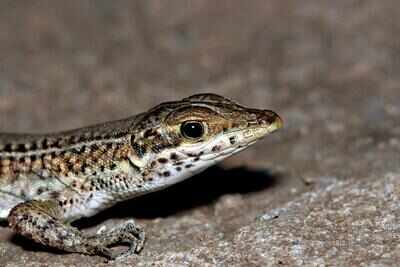
Surat: The repitalian diversity is becoming rich with the discovery of new species from the state in the last few years. Experts say that Gujarat is one of the most diversified states in India with respect to biodiversity.
The new species snake-eyes’ (Ophisops) is the fourth endemic species of reptile discovered from Gujarat in the last 12 years. Earlier in 2009, a new species of Gecko was discovered from Girnar hills in Junagadh and was named as Gujarat Gecko (Hemidactylus gujaratensis).
Moreover, a new species of snake named as Wallace’s Racer (Wallaceophis Gujaratensis), a species of colubrid snake that is found in central Gujarat and Saurashtra, was discovered in 2016.
Scientists discovered another lizard species from Kutch in 2018 and named it ‘Kutch Snake-eye’ (Ophisops kutchensis). This species of lacerta is occurring in the parts of Kutch and Saurashtra and endemic to the state. Expert say that this lizard is brown in colour and have stripes running drown its body.
“Various types of habitats from dry desert to moist deciduous forests, and seashore along the coastal islands with mangrove forests and mud flats are available in Gujarat.
This provides a conducive environment for many organisms,” Raju Vyas, a reptile expert from Vadodara, told TOI.
According to a research paper authored by Raju Vyas and Harshil Patel titled ‘Reptiles of Gujarat, India: Updated checklist, distribution and Conservation status’, the present number of reptile species of Gujarat now stands at 131, a number that includes 22 erroneously or dubiously reported species and one non-native species.
In 2000, a total of 107 species reptiles were recorded. They have now increased to 131 species.
Researchers recorded one species of crocodile, nine species of chelonians belonging to five families, 43 species of lizards belonging to seven families, and 54 species of snakes belonging to 10 families from the state.
“The study also revealed that among the regions of Gujarat, South Gujarat was found to have the highest reptilian diversity among the five regions (75 species), followed by Saurashtra (74 species), Central Gujarat (71 species), Kutch (52 species), and North Gujarat (51 species),” said Patel.
“Diverse habitats of the state are rapidly changing due to the new developmental projects such as irrigation projects and industrial projects. Forest areas are being denotified for the implementation of development projects such as mining, industry, communication and tourism.
This is resulting in shrinkage, fragmentation, degradation and destruction of natural habitats and threat to reptilian species,” explained Vyas.
The new species snake-eyes’ (Ophisops) is the fourth endemic species of reptile discovered from Gujarat in the last 12 years. Earlier in 2009, a new species of Gecko was discovered from Girnar hills in Junagadh and was named as Gujarat Gecko (Hemidactylus gujaratensis).
Moreover, a new species of snake named as Wallace’s Racer (Wallaceophis Gujaratensis), a species of colubrid snake that is found in central Gujarat and Saurashtra, was discovered in 2016.
Scientists discovered another lizard species from Kutch in 2018 and named it ‘Kutch Snake-eye’ (Ophisops kutchensis). This species of lacerta is occurring in the parts of Kutch and Saurashtra and endemic to the state. Expert say that this lizard is brown in colour and have stripes running drown its body.
“Various types of habitats from dry desert to moist deciduous forests, and seashore along the coastal islands with mangrove forests and mud flats are available in Gujarat.
This provides a conducive environment for many organisms,” Raju Vyas, a reptile expert from Vadodara, told TOI.
According to a research paper authored by Raju Vyas and Harshil Patel titled ‘Reptiles of Gujarat, India: Updated checklist, distribution and Conservation status’, the present number of reptile species of Gujarat now stands at 131, a number that includes 22 erroneously or dubiously reported species and one non-native species.
In 2000, a total of 107 species reptiles were recorded. They have now increased to 131 species.
Researchers recorded one species of crocodile, nine species of chelonians belonging to five families, 43 species of lizards belonging to seven families, and 54 species of snakes belonging to 10 families from the state.
“The study also revealed that among the regions of Gujarat, South Gujarat was found to have the highest reptilian diversity among the five regions (75 species), followed by Saurashtra (74 species), Central Gujarat (71 species), Kutch (52 species), and North Gujarat (51 species),” said Patel.
“Diverse habitats of the state are rapidly changing due to the new developmental projects such as irrigation projects and industrial projects. Forest areas are being denotified for the implementation of development projects such as mining, industry, communication and tourism.
This is resulting in shrinkage, fragmentation, degradation and destruction of natural habitats and threat to reptilian species,” explained Vyas.

Coronavirus outbreak
Trending Topics
LATEST VIDEOS
City
 On cam: Fort wall collapses after heavy rains in Telangana
On cam: Fort wall collapses after heavy rains in Telangana  Kerala gold smuggling case: Accused have links with Dawood Ibrahim, says NIA
Kerala gold smuggling case: Accused have links with Dawood Ibrahim, says NIA  'Red light on, gaadi off': Delhi CM Arvind Kejriwal urges people to take pledge to reduce air pollution
'Red light on, gaadi off': Delhi CM Arvind Kejriwal urges people to take pledge to reduce air pollution  Delhi Unlock 5: Movie theatres reopen with limited seating capacity
Delhi Unlock 5: Movie theatres reopen with limited seating capacity
More from TOI
Navbharat Times
Featured Today in Travel
Quick Links
Get the app



